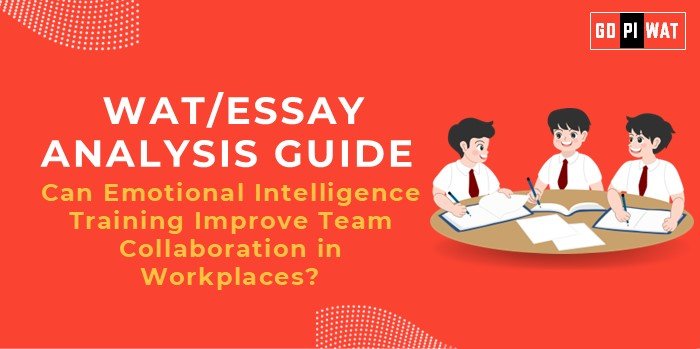📋 WAT/Essay Analysis Guide
🌟 Topic: Can Emotional Intelligence Training Improve Team Collaboration in Workplaces?
🌐 Understanding Emotional Intelligence’s Importance
Emotional Intelligence (EI) training addresses the emotional and social factors that often determine team collaboration, productivity, and leadership success. In the context of modern workplaces, EI plays a pivotal role in conflict resolution, stress management, and creating cohesive teams.
📊 Effective Planning and Writing
- Time Allocation (30 minutes):
- Planning: 5 minutes
- Writing: 20 minutes
- Review: 5 minutes
- Preparation Tips: Identify relevant statistics, case studies (e.g., Google, Microsoft), and real-world challenges.
✍️ Introduction Techniques for Essays
-
Contrast Approach:
“While technical skills help individuals excel, workplaces often fail due to a lack of emotional intelligence among team members.” -
Solution-Based:
“Introducing emotional intelligence training could be the key to solving conflicts and enhancing team collaboration in workplaces.”
🏗️ Structuring the Essay Body
1. Achievements
- Example: Microsoft’s EI leadership training led to a 20% boost in productivity.
- Analysis: Highlight how empathy and self-awareness improve team cohesion.
2. Challenges with Comparative Analysis
- Example: Cultural resistance to EI training in some traditional corporate structures.
- Global Benchmark: Denmark and Google’s success stories demonstrate scalable EI training benefits.
3. Future Outlook
- Recommendation: Implement AI-driven EI tools and continuous training modules.
- Vision: A workforce where emotional intelligence is as valued as technical expertise.
📈 Concluding Effectively
-
Balanced Perspective:
“While emotional intelligence training may not be a magic bullet, its ability to foster trust, reduce stress, and enhance collaboration makes it an essential tool for modern workplaces.” -
Global Comparison:
“Organizations like Google and Microsoft highlight that investing in EI is key to building resilient, high-performing teams.”
🔍 Analyzing Successes and Shortcomings
- Achievements: Increased collaboration, reduced conflicts, and improved leadership.
- Challenges: Measuring impact, overcoming cultural biases, and ensuring consistency.
- Global Context: Denmark’s success in emotional learning sets a benchmark for corporate applications.
✅ Recommendations for Sustainable Progress
- Implement EI training at all managerial levels to influence team dynamics.
- Use AI tools for assessing and improving emotional intelligence.
📘 Sample Short Essays
1. Balanced Perspective (100 words)
“Technical skills alone are not enough for workplace success. Emotional intelligence training builds empathy, trust, and resilience, transforming team collaboration. However, its effectiveness depends on consistent implementation and measurable goals.”
2. Solution-Oriented (100 words)
“Organizations face billions in losses due to conflicts. Emotional intelligence training, as demonstrated by Google and Microsoft, can resolve these issues by improving communication, reducing stress, and creating harmonious teams.”
3. Global Comparison (100 words)
“Companies like Adobe and countries like Denmark emphasize emotional intelligence as a cornerstone of collaboration. By adopting similar training models, workplaces can enhance productivity and employee satisfaction globally.”
✨ Final Thoughts
This guide ensures clarity, depth, and practical relevance for B-school aspirants, providing ready-to-use content for both group discussions and essays.


